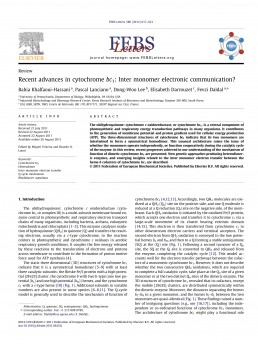Recent advances in cytochrome bc(1): inter monomer electronic communication?
Abstract
The ubihydroquinone: cytochrome c oxidoreductase, or cytochrome bc(1), is a central component of photosynthetic and respiratory energy transduction pathways in many organisms. It contributes to the generation of membrane potential and proton gradient used for cellular energy production (ATP). The three-dimensional structures of cytochrome bc(1) indicate that its two monomers are intertwined to form a symmetrical homodimer. This unusual architecture raises the issue of whether the monomers operate independently, or function cooperatively during the catalytic cycle of the enzyme. In this review, recent progresses achieved in our understanding of the mechanism of function of dimeric cytochrome bc(1) are presented. New genetic approaches producing heterodimeric enzymes, and emerging insights related to the inter monomer electron transfer between the heme b cofactors of cytochrome bc(1) are described
CategoryReviewDate2011.08Linkwww.ncbi.nlm.nih.gov
